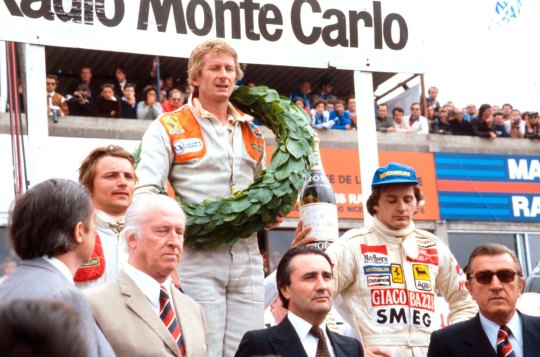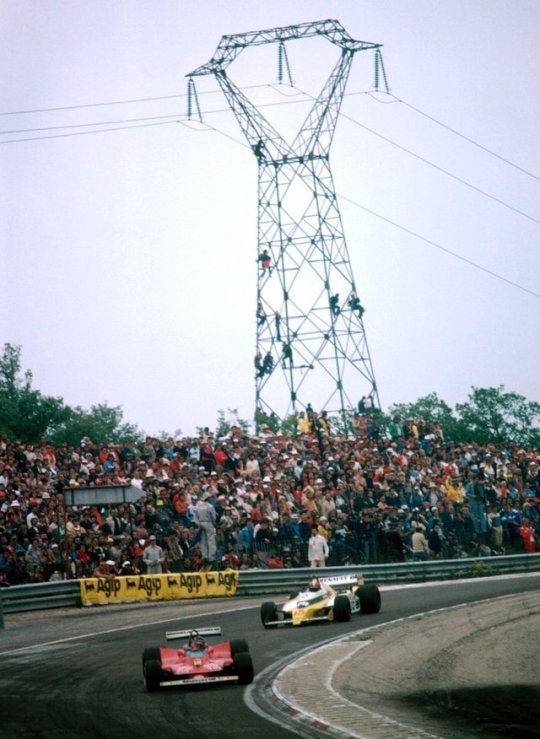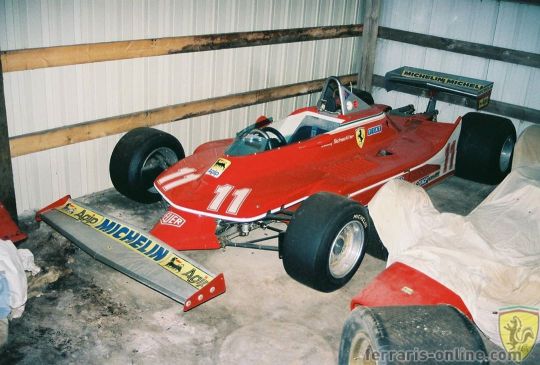#dijon f1 1979
Explore tagged Tumblr posts
Text
Sergio's Exclusive Chat with René Arnoux: The driver must drive!
Sergio's Exclusive Chat with René Arnoux: The driver must drive!
Interview and photos by Sergio Álvarez. He’s a seven-time Grand Prix winner in what was one of the most dangerous, yet exciting, periods of Formula 1 history. He drove for one of the biggest names in our sport (Enzo Ferrari) and he was cool, he is still very cool indeed. He rubbed shoulders with giants. The quintessential French driver of the best and most diverse era of F1 racing. Did I…

View On WordPress
#f1#arnoux villeneuve dijon 1979#dijon f1 1979#formula 1#formula one#gilles villeneuve#iberianmph#lando norris#ortolan#renault f1#renault f1 team#renault turbo f1#Renaulution#rené arnoux#rene arnoux#sergio alvarez#sergio álvarez#simply lovely
1 note
·
View note
Photo

RIP Jean-Pierre Alain Jabouille (1942- 2023).
Jean-Pierre Jabouille (Renault) vainqueur, Gilles Villeneuve (Ferrari) 2ème et René Arnoux (Renault) 3éme du Grand Prix de France - Dijon-Prenois 1979. - source F1 Old an New.
#jean-pierre jabouille#gilles villeneuve#rené arnoux#renault#ferrari#grand prix de france#dijon-prenois
34 notes
·
View notes
Text
Jean-Pierre Jabouille: First Renault driver to win a Formula 1 grand prix dies aged 80
Jean-Pierre Jabouille, right, with Renault team-mate Rene Arnoux at the 1979 French Grand Prix, where he earned Renault's first victory in Formula 1 Former Grand Prix driver Jean-Pierre Jabouille, the man who took Renault's first Formula 1 win, has died aged 80. The Frenchman was a key part of Renault's 1977 entry into Formula 1 - and they were the first manufacturer to use a turbocharged engine. Jabouille took Renault's maiden win in the 1979 French Grand Prix. His final victory came in Austria in 1980, but his career was ended later that year when he broke a leg in a crash in Canada. He had been in any case due to leave the Renault team because his seat had been taken by rising star Alain Prost for 1981. Jabouille tried to return with the Talbot Ligier team, but was clearly unfit and retired as a driver after failing to qualify for two of his four attempts. The Alpine team, owned by Renault, said in a statement that it was "incredibly saddened" by Jabouille's death. "A humble racing driver, brilliant engineer and a pioneer of our sport. Jean-Pierre was a true racer. "He spearheaded Renault's journey into F1 in 1977 with his resilient and dare-to-do attitude. He was Renault's first Grand Prix winner in 1979, a landmark moment in Renault's journey in Formula 1. "His determination and dedication to succeed inspired many, and these values remain central to the current team in its now blue colours of Alpine. "We are where we are today because of Jean-Pierre and his legacy lives on." Jabouille, an engineer by trade, joined the Renault F1 project from its start to help develop its new turbo engine. At the time, F1 was dominated by naturally aspirated three-litre V8s but Renault was the first to see the potential of an equivalence formula that permitted the use of 1.5-litre turbos. Initially, the car was a laughing stock, dubbed the "yellow teapot" by British rivals because of its poor reliability. But the engine was immediately more powerful than the V8s used by other teams. Assiduous work improved the engine's reliability and, by 1979, the team also had a competitive chassis. Their maiden victory could not have come in more ideal circumstances for a team representing France's national car company: it came on home soil at Dijon-Prenois, with a French driver in a French car with a French engine using French Michelin tyres. Jabouille in the Renault F1 car at the 1979 US Grand Prix The sadness for both Jabouille and Renault is that the race was destined to be more famous for the gripping racing between his team-mate Rene Arnoux and Ferrari's Gilles Villeneuve for second place. One of the greatest duels in F1 history was eventually settled in Villeneuve's favour after a final few laps marked by improbable overtaking moves, regular position swaps, off-track moments and wheel-banging incidents. Jabouille had earlier in the season taken the team's first pole position, aided by the high altitude at the South African Grand Prix at Kyalami, and he took two further poles that year in Germany and Italy, although poor reliability prevented any further wins. In 1980, Jabouille took two more poles along with his win in Austria, while Arnoux won twice in South Africa and Brazil. After his retirement from F1, Jabouille was briefly a manager at the Ligier team, before stepping away. He returned as head of the ill-fated Peugeot engine programme in the 1990s. Peugeot, fresh from winning Le Mans in 1993, joined forces with McLaren for 1994, but the relationship was a tense one and it ended early - after just one season of poor performance and reliability. Peugeot switched to Jordan from 1995-97 and then to Prost's team from 1998 before withdrawing at the end of 2000. via BBC Sport - Formula 1 http://www.bbc.co.uk/sport/
#F1#Jean-Pierre Jabouille: First Renault driver to win a Formula 1 grand prix dies#aged 80#Formula 1
3 notes
·
View notes
Photo

Gilles Villeneuve (Ferrari 312T4) swiftly passes René Arnoux (Renault RS10) on the last lap of the 1979 French Grand Prix at Dijon-Prenois after an incredible battle that is regarded as one of the best in the history of the sport.
#Gilles Villeneuve#Ferrari#Ferrari 312T4#René Arnoux#Rene Arnoux#Renault#Renault RS10#1979#French Grand Prix#Grand Prix de France#Dijon-Prenois#F1#Formula One#Formula 1#Grand Prix
76 notes
·
View notes
Text
50 ans du circuit Dijon-Prenois : un demi-siècle dans le rétro
50 ans du circuit Dijon-Prenois : un demi-siècle dans le rétro

View On WordPress
#automobile#Circuit Dijon-Prenois#Circuit Never-Magny-Cours#Claude Bourillot#Côte-d’Or#Dijon#Dijon-Prenois#F1#Formule 1#François Chambelland#Grand Prix de France 1979#Jean Gadeski#prenois#sport automobile#Yannick Morizot
0 notes
Text








The duel of Dijon ⚔️ | French GP 🇨🇵 1979
The first victory in F1 for Jean-Pierre Jabouille, which was also the first victory for Renault, was 'slightly' overshadowed by the legendary, and fierce, battle for second place between Ferrari driver Gilles Villeneuve and Renault driver René Arnoux. The battle took place in the final laps of the race, when the two drivers kept swapping positions and touched with their wheels several times. Eventually Gilles finished 0.24 seconds ahead of René.
#gilles villeneuve#rene arnoux#jean pierre jabouille#classic f1#f1#formula 1#retro f1#f1 1970s#ferrari#reanault
75 notes
·
View notes
Note
for the ask game!
Giuseppe Farina & Denny Hulme
<3
Giuseppe Farina: First F1 race you watched? i'd say 2012/2013 (?) my dad was a big fan of rbr vettel at that time Denny Hulme: if you could go back and watch any F1 race in person what one would you choose? ngl i can't choose between monaco 1982, hungary 2017, suzuka 2005, and dijon 1979
4 notes
·
View notes
Photo


Renault F1 RS 10, 1979. For the 2019 Rétromobile shown this week, Renault celebrating the 40th anniversary of its first Formula 1 victory. Jean-Pierre Jabouille claimed Renault’s first Grand Prix victory in 1979 on the Dijon-Prenois track in France at the wheel of the RS 10. It was the first Formula 1 win by the Renault-Gordini EF1 engine, and the first-ever F1 victory using a turbocharged engine.
70 notes
·
View notes
Photo

#Bruno Giacomelli #Alfa Romeo #GP France-Dijon 1979 #F1
13 notes
·
View notes
Photo

Continueing F1 week(S) 1979 Ferrari 312 T4 Although not as fast on the straights as the Renaults or as fast through the corners as the purpose built ground effects racers, the rock solid reliability and grunt of the 312 T4 brought Ferrari yet another driver's and constructor's world championship. Scheckter beat Villeneuve by four points, but the latter stole the show that season; particularly at Dijon where he fought off Rene Arnoux in his Renault in some of the most epic and closely contested laps in the sport's history #formula1 #ferrari #formulaone #scuderiaferrari #mclaren #hemmings #cokertire #barnfinds #vault #porsche #vintage #drivetastefully #classiccar #nature #barnfindhunters #vettel #sebastianvettel #barnfind #redbull #prancinghorse #redseason #lewishamilton #redbullracing #senna #tororosso #sennasempre #monaco #williams #hamilton #ayrtonsenna https://www.instagram.com/p/B--c7G_FANz/?igshid=1ouw609f9sqt6
#formula1#ferrari#formulaone#scuderiaferrari#mclaren#hemmings#cokertire#barnfinds#vault#porsche#vintage#drivetastefully#classiccar#nature#barnfindhunters#vettel#sebastianvettel#barnfind#redbull#prancinghorse#redseason#lewishamilton#redbullracing#senna#tororosso#sennasempre#monaco#williams#hamilton#ayrtonsenna
1 note
·
View note
Photo

1979. Jean-Pierre Jabouille picks up the first victory for @renaultsportf1 - 40 years of Renault in F1 in photos. Full story on ColumnM.com... link in bio. . . . . . #f1 #racing #motorsport #formula1 #formulaone #renault #renaultsport #historicracing #retrogp (at Circuit automobile de dijon-prenois)
2 notes
·
View notes
Photo



I first met George Harrison when the Beatles turned up at the Monaco Grand Prix in 1969.
George enjoyed motor racing and, in 1979, he released a single called Faster which, the cover explained, was "inspired by Jackie Stewart and Niki Lauda and dedicated to the entire F1 circus".
The chorus ended:
No one knows quite how he does it but it's true they say
He's the master of going faster.
I can just see George sitting somewhere getting an idea in his head, then scribbling the words on the back of a cigarette packet. That was his genius.
We had fun shooting the music video for Faster, in which I made a cameo appearance as George's chauffeur, wearing a white hat with a tartan band, similar to my old racing helmet.
I drove the Daimler while, on the other side of a glass partition, George sat strumming on his guitar, singing.
Our closeness seemed to confirm the old saying that opposites attract. While I like to organise my life with military precision, George took a more laid-back approach.
I remember one time, at an airport, I was starting to worry whether we would get to the gate on time but George just smiled and said he wanted a cup of tea.
"OK," I fretted, "but I don't think we have time."
"There's always time for a cup of tea," he said.
If we had been dropped from the same height, George would have been a feather, drifting this way and that on the breeze; I would have been a lead weight plunging straight down.
There were times when we could have been living on different planets, when George was procrastinating and I would be all action, when he was wearing way-out clothes and I was traditionally dressed. But we were alike in paying fanatical attention to detail.
He could be amazingly fastidious, keeping his cars immaculately clean, working on a song until it was so precisely right that it would sound as if it had evolved out of nothing, dreamily and effortlessly.
We shared many wonderful times. On one occasion, when he was staying with us in Switzerland, we went to the French Grand Prix in Dijon. It was a clear, warm evening when we arrived home. Helen had prepared a barbecue, and Paul, who was 12 at the time, brought out his guitar.
George started to play, running through all the great Beatles hits, singing parts of the songs, explaining what the lyrics meant to various members of the band. I remember sitting there, thinking this had to be one of the greatest privileges anybody could have.
- Jackie Stewart
49 notes
·
View notes
Photo

Gilles Villeneuve - René Arnoux - Grand Prix de France - Dijon-Prenois 1979. - source F1 Fotos.
41 notes
·
View notes
Text
Double F1 race winner Jean-Pierre Jabouille passes away aged 80
Jean-Pierre Jabouille, the two-time Grand Prix winner who claimed Renault’s first F1 victory, has died at the age of 80. Frenchman Jabouille made 49 starts across an F1 career that began with Williams in 1974 and ended with Ligier in 1981 – via spells at Surtees, Tyrrell and the aforementioned Renault. Two years after joining Renault, Jabouille scored a landmark home win for himself and the team at the 1979 French Grand Prix, held at Dijon, leading home Ferrari rival Gilles Villeneuve and team mate Rene Arnoux, who were involved in a remarkable and now legendary skirmish for the runner-up spot. Jabouille and Renault secured another triumph together at the following year’s Austrian Grand Prix – the Paris-born racer also taking six pole positions and ending his F1 career with 21 points. Alongside F1, Jabouille claimed the European F2 title in 1976 and collected four podium finishes at the famous 24 Hours of Le Mans. Jabouille en route to his and Renault’s famous win at Dijon in 1979 Speaking of Jabouille’s passing, Formula 1 CEO and President Stefano Domenicali said: “I am saddened by the news that Jean-Pierre Jabouille has passed away. He gave so much to motorsport and F1 and we cherish his memory and achievements. Our thoughts are with his family and friends at this sad time.” The current Alpine team – backed by Renault – released a statement saying they were “incredibly saddened” to hear of Jabouille’s passing, describing him as “a humble racing driver, brilliant engineer, and a pioneer of our sport”, along with being “a true racer”. Their message continued: “He spearheaded Renault’s journey into F1 in 1977 with his resilient and dare to do attitude. He was Renault’s first Grand Prix winner in 1979, a landmark moment in Renault’s journey in Formula 1. “His determination and dedication to succeed inspired many, and these values remain central to the current team in its now blue colours of Alpine. “We are where we are today because of Jean-Pierre and his legacy lives on. We’d like to extend our most sincere condolences to his family and close friends.” via Formula 1 News https://www.formula1.com
1 note
·
View note
Text
Renault with Formula 1 Anniversary: 40 years ago first turbo victory
Renault with Formula 1 Anniversary: 40 years ago first turbo victory
[ad_1]
Anniversary of the Renault F1 Team: 40 years ago, on July 1, 1979, Renault achieved the first turbo victory in Formula 1 at the Dijon French Grand Prix. The triumph of Jean-Pierre Jabouille also marked the first victory of the Renault factory team in the kings class of motorsport. Jabouille made a few honorary rounds at the Circuit Paul Ricard at this year's edition of the French Grand…
View On WordPress
0 notes
Text
F1: Jabouille aimerait "que la voiture soit un peu endommagée en cas de sortie de route" 78682 homes
http://www.78682homes.com/f1-jabouille-aimerait-que-la-voiture-soit-un-peu-endommage-en-cas-de-sortie-de-route
F1: Jabouille aimerait "que la voiture soit un peu endommagée en cas de sortie de route"
Vainqueur en juillet 1979 avec Renault du GP de France sur le circuit de Dijon-Prenois, première victoire en F1 d’un moteur turbo-compressé, l’ex-pilote français Jean-Pierre Jabouille souhaiterait voir aujourd’hui des courses moins aseptisées où une sortie de route aurait plus de conséquences.Considéré comme l’un des derniers « pilotes ingénieurs », il juge lors d’un entretien à l’AFP en marge du GP de France qui se disputera dimanche au Castellet, que le rôle de celui-ci est…
homms2013
#Informationsanté
0 notes